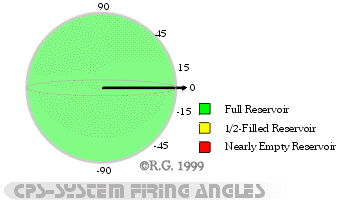| SAMPLE
WEAPONS IN THIS CATEGORY CPS1000, CPS1500, CPS2000, CPS2500, CPS3000 |
|
| FIRING ANGLE LIMITATIONS | |
| Thanks to the natures of the CPS-technology, these weapons do not have any firing angle limitation. They are, however, still limited on their filling angle when pumping. |  |
PRIMING
BEFORE USE
Since all CPS weapons have a separate pressurized firing chamber based
on an elastic force, air is not needed and can reduce the amount of water
available to launch at one's foe. Before engaging the enemy with a newly
filled CPS-based blaster, it is best to pump up the firing chamber part-way,
then fire upwards to clear air from the firing chamber. This process should
be repeated a couple of times until no more air is being expelled from
the blaster. This primes the blaster very well and results in better soak-times
in general.
MAXIMIZING USE
Since all CPS weapons have a separate pressurized firing chamber,
one way to get an extra shot is to fill the tank first, pump to fill the
firing chamber, then top off the tank. This will give one extra full burst,
a definite plus especially considering how fast one can empty the blaster
due to their increased firing rate.
When first filling the pressure chamber, some air may end up within it,
resulting in a frothy stream when firing. To reduce/eliminate unwanted
air from the firing chamber, pump up the chamber, point the CPS directly
up, shake, and fire until a nice, solid stream is produced. This primes
the weapon for use.
Cheap Trick: If one is almost out of water and is being pursued, one can fill the firing chamber with water, then unscrew the reservoir's cap and shake the blaster upside-down as if to say that one is out of ammo. If one's foes are a little too presumptuous, they will approach you without fear which is when you can, surprise, unleash a full burst of water onto them. Unfortunately, this trick usually does not work for veteran water warriors or those who have already seen it done.
CONSERVE WATER
CPS-based weapons use up their water at a ridiculous rate. As such,
one can easily empty one's entire water reservoir before those air-pressure
based systems finish squeezing off a second shot. Definitely avoid using
full firing chamber bursts unless the soak is guaranteed. If applicable,
switch to a lower nozzle setting when one's water reservoir is running
low.
CLEARING WATER
CPS-based weapons tend to trap a good amount of water in their CPS-firing
chamber even after the initial pressure is released. If the blaster is
not to be used again for awhile (i.e. more than 24 hours), it is best
to ensure as much water as possible is removed from the firing chamber.
The reservoir should be emptied and then air pumped into the firing chamber.
When pumping, hold the blaster upside down to force any residual water
from the pump into the firing chamber. Once a few pumps of air have entered
the firing chamber, point the blaster with nozzle aimed at the ground
and pull the trigger. Repeat this until little or no mist is ejected.
On blasters which do no pump air (some of the CPS series has some peculiar
air/water valve), hold the trigger down while pointing the blaster downwards
and pumping. The less water remaining in the firing chamber means the
less likelihood of mildew or other "buggies" from gumming up
the blaster.